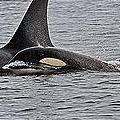 加拿大境內六個環保團體8日對「海洋暨漁業部」(Department of Fisheries and Oeans,DFO)提出告訴,控訴該部未能保護虎鯨在卑詩省沿岸海域的重點棲地。
加拿大境內六個環保團體8日對「海洋暨漁業部」(Department of Fisheries and Oeans,DFO)提出告訴,控訴該部未能保護虎鯨在卑詩省沿岸海域的重點棲地。
訴訟內容宣稱,該部未能保衛棲息於卑詩省海域兩群海洋哺乳動物的棲地,一群是定居南方瀕臨絕種的虎鯨,另一群則是在北方定居受到威脅的虎鯨,這兩個族群皆已正式列入加拿大《瀕危物種法》(Species at Risk Act)保護名單。
代表原告方的法律事務所「環境正義」(Ecojustice)律師狄莎蘿(Lara Tessaro)指出:「這類訴訟案件在加拿大還是頭一遭」。
虎鯨,又稱為殺手鯨(Killer Whale,編註),是鯨豚家族的成員之一,牠們的壽命較長,在海洋食物網中屬於頂層的掠食者。生物學家將太平洋東北海域的虎鯨分成三種不同的類別:定居、暫居與近海等三類。
定居在南方的虎鯨族群,其重點棲地範圍包括聖胡安與海灣群島的鄰近海域,以及在北喬治亞海峽、約溫哥華島中北部的海域。區域中虎鯨出現的時間與鮭魚遷徙經過這些海域的時機吻合,因為鮭魚是牠們主要的食物來源。
 在北方定居的虎鯨族群,其重點棲地包含約翰斯頓海峽(Johnstone Strait)與夏洛特女王海峽(Queen Charlotte Strait),以及連接這兩個海峽之間的水道。
在北方定居的虎鯨族群,其重點棲地包含約翰斯頓海峽(Johnstone Strait)與夏洛特女王海峽(Queen Charlotte Strait),以及連接這兩個海峽之間的水道。
9月10日,在未諮詢虎鯨學者的情況下,加拿大海洋暨漁業部拒絕發佈《瀕危物種法》中保護定居虎鯨重點棲地以防遭受破壞的命令。該部發表聲明宣稱,虎鯨的棲地皆受到現今法令與政策的保護。
儘管鮭魚的數量正在減少,海運變得更為繁忙,毒性汙染物質流入海洋,挖泥噪音、地震測試與軍用聲納干擾,虎鯨仍試圖在這些逆境中存活下來。
大衛鈴木基金會(David Suzuki Foundation)、環境保衛基金會(Environmental Defence)、加拿大綠色和平組織(Greenpeace Canada)、國際動物福利基金會(International Fund for Animal Welfare)、雨岸保育協會(Raincoast Conservation Society)、荒野保護委員會(Wilderness Committee)等六個環保團體,對於政府無法履行《瀕危物種法》來保護虎鯨感到挫折,進而尋求法律途徑。
這起訴訟接續「定居虎鯨復育團隊」(Resident Killer Whale Recovery Team)長達兩年的努力,該團隊由獨立與政府的科學家組成,任務是為虎鯨籌備復育計畫(Recovery Strategy),確保計畫中包含虎鯨重點棲地的資訊。
「定居虎鯨復育團隊」的共同主席,虎鯨專家巴瑞蘭納博士(Dr. Lance Barrett-Lennard)表示,本團隊已多次抵抗政府高層官員企圖將重點棲地移除,並消弭由本團隊提供接近完成的科學資訊。
南北區域定居虎鯨的最終復育計畫(Final Recovery Strategy)是在2008年3月14日由海洋暨漁業部發表,該計畫認定並在地圖上標示出定居虎鯨的重點棲地,同時也提出其他透過進一步研究後可能成為重點棲地但尚未受到保護的區域。
The federal Department of Fisheries and Oceans was sued today by six environmental groups from across Canada for failure to safeguard the critical habitat of killer whales that reside in British Columbia coastal waters.
The lawsuit alleges that the department has failed to protect the critical habitat of two populations of marine mammals that inhabit British Columbia waters - the endangered southern resident killer whales and the threatened northern resident killer whales - both formally listed under the Species at Risk Act.
"This is the first lawsuit ever of its kind in Canada," said Lara Tessaro, staff lawyer at Ecojustice, the law firm representing the plaintiff groups.
Killer whales, also known as orcas, are long-lived members of the dolphin family and top predators in the marine food web. In the Northeast Pacific Ocean, biologists classify killer whales into three distinct groups - resident, transient, and offshore.
The critical habitat of the southern resident killer whale population includes the waters around the San Juan and Gulf Islands, and up Georgia Strait about mid-way up Vancouver Island. The occurrence of the southern resident whales in this area is correlated with the timing of salmon migration through these waters, as salmon is their primary food source.
The critical habitat of the northern resident killer whale population includes the waters of Johnstone Strait and southeastern Queen Charlotte Strait, and the channels connecting these straits.
On September 10, without consulting killer whale scientists, the Department of Fisheries and Oceans declined to issue an order under the federal Species at Risk Act to protect the resident killer whales’ critical habitat from destruction.
The department issued a statement claiming that resident killer whale critical habitat is protected by existing laws and policies.
These killer whales are attempting to survive despite decreasing numbers of salmon; increased boat traffic; toxic contamination; and noise from dredging, seismic testing and military sonar.
Frustrated by the federal government’s failure to take steps under the Species at Risk Act to protect the orcas, the David Suzuki Foundation, Environmental Defence, Greenpeace Canada, the International Fund for Animal Welfare, the Raincoast Conservation Society and the Wilderness Committee have turned to the courts.
The lawsuit follows a two-year struggle by the Resident Killer Whale Recovery Team - independent scientists and government scientists tasked with preparing a Recovery Strategy for these orcas - to ensure that the recovery plan included information showing the orcas’ critical habitat.
Orca expert Dr. Lance Barrett-Lennard, co-chair of the Resident Killer Whale Recovery Team, has said that the team resisted multiple attempts by senior government officials to remove critical habitat and other scientific information from the Resident Killer Whale Recovery Strategy prior to its completion.
The Final Recovery Strategy for the Northern and Southern Resident Killer Whales was released by Fisheries and Oceans Canada on March 14, 2008. It identified and mapped some areas that are critical habitat for resident killer whales, and suggested other areas that, with further research, may also be identified as critical habitat, but these areas have not been protected.
全文及圖片詳見:ENS



